
How to Use nRF24L01 : Examples, Pinouts, and Specs
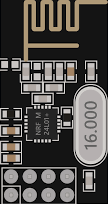
 Design with nRF24L01 in Cirkit Designer
Design with nRF24L01 in Cirkit DesignerIntroduction
The nRF24L01 is a low-power 2.4 GHz transceiver module manufactured by Nordic Semiconductor. It is widely used for wireless communication in various applications due to its low power consumption, high data rate, and reliable performance. The module operates in the globally available ISM (Industrial, Scientific, and Medical) band, making it suitable for short-range wireless communication.
Explore Projects Built with nRF24L01
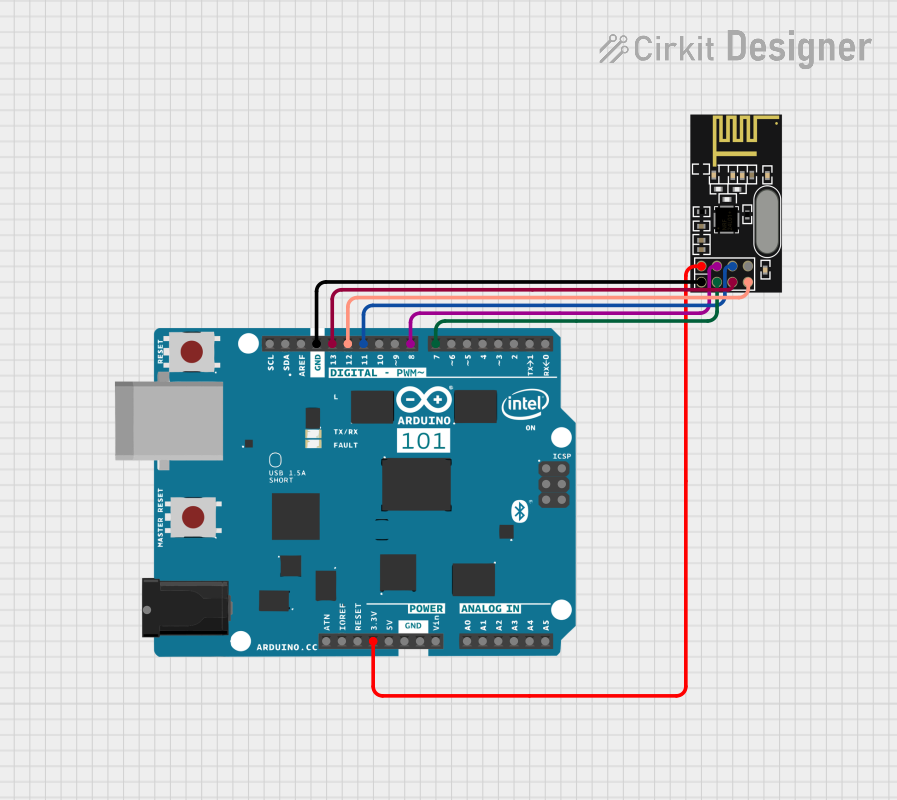
 Open Project in Cirkit Designer
Open Project in Cirkit Designer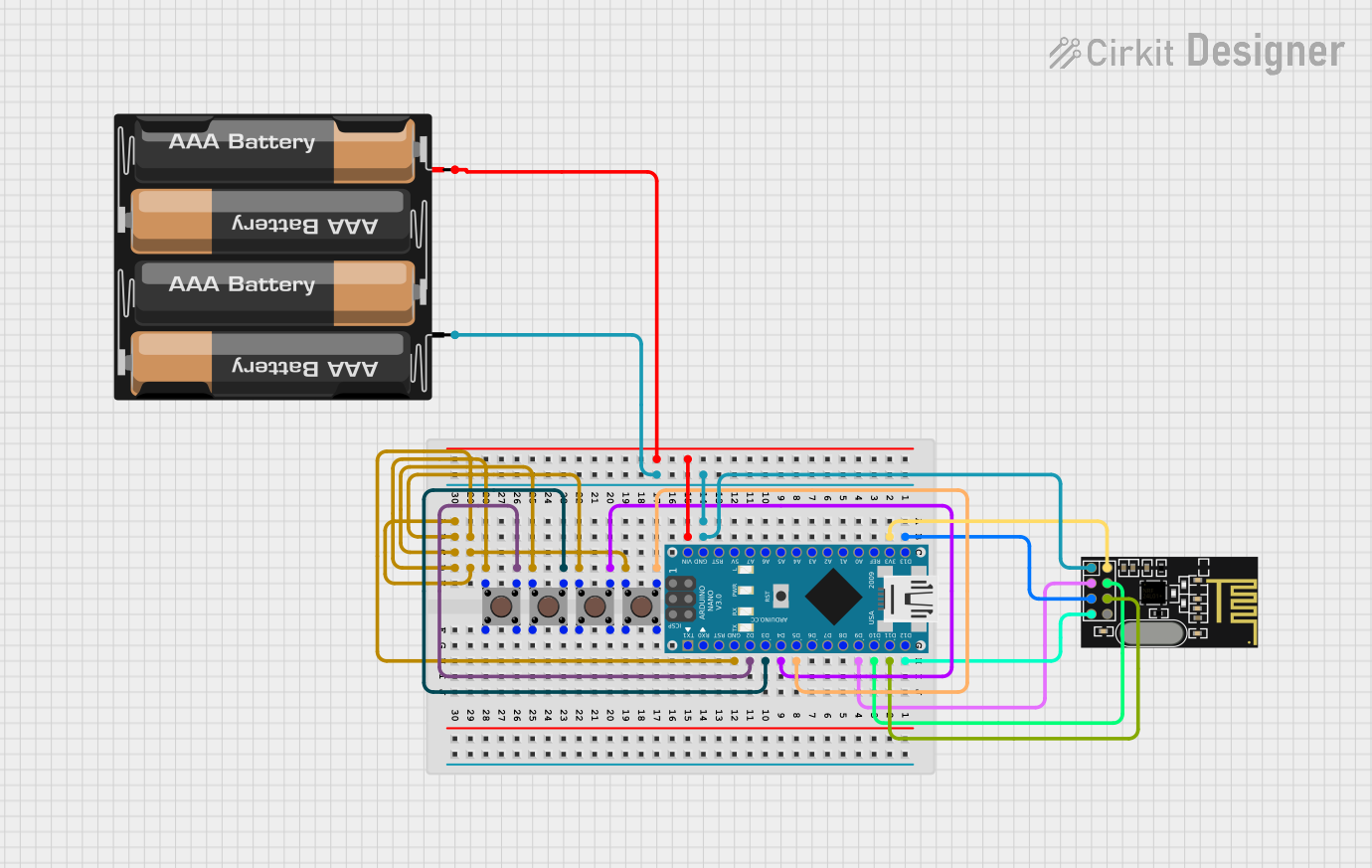
 Open Project in Cirkit Designer
Open Project in Cirkit Designer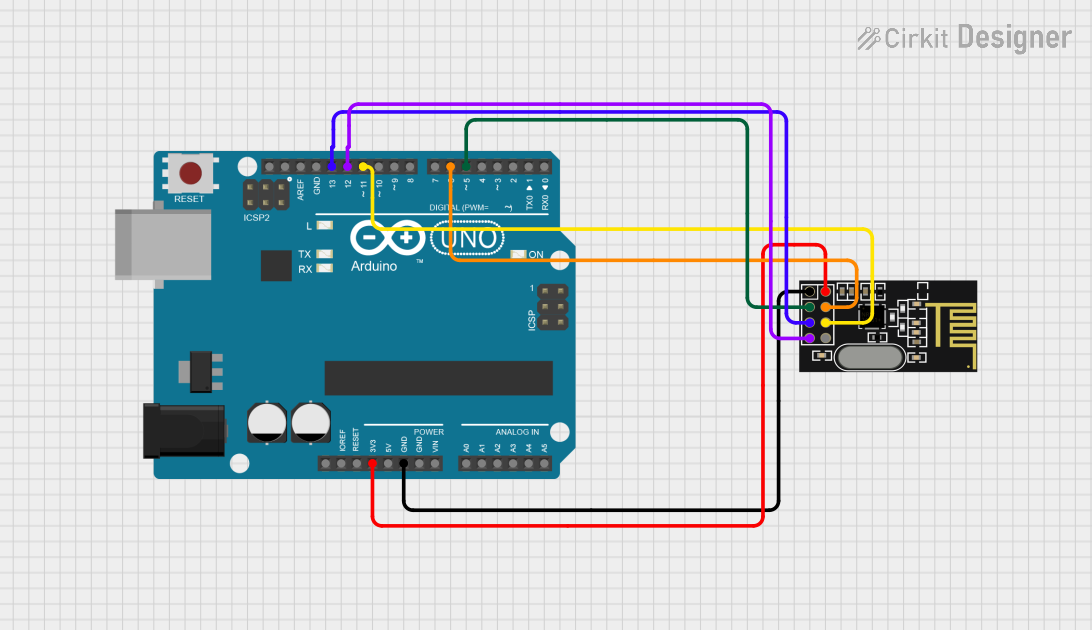
 Open Project in Cirkit Designer
Open Project in Cirkit Designer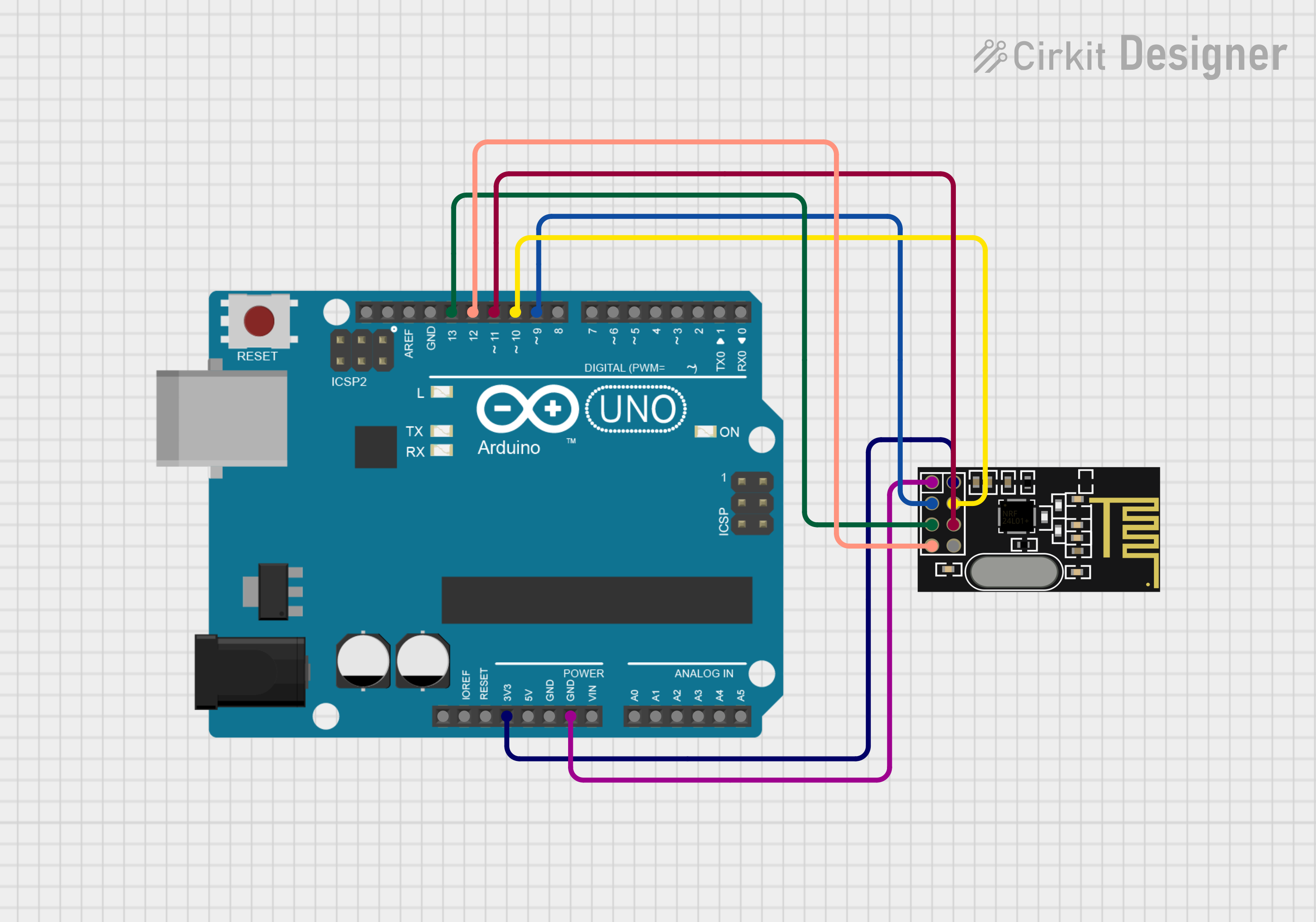
 Open Project in Cirkit Designer
Open Project in Cirkit DesignerExplore Projects Built with nRF24L01

 Open Project in Cirkit Designer
Open Project in Cirkit Designer
 Open Project in Cirkit Designer
Open Project in Cirkit Designer
 Open Project in Cirkit Designer
Open Project in Cirkit Designer
 Open Project in Cirkit Designer
Open Project in Cirkit DesignerCommon Applications and Use Cases
- Wireless sensor networks
- Remote control systems (e.g., drones, RC cars)
- Home automation
- Internet of Things (IoT) devices
- Wireless data logging
- Industrial monitoring and control systems
Technical Specifications
The following table outlines the key technical details of the nRF24L01 module:
| Parameter | Value |
|---|---|
| Operating Frequency | 2.4 GHz ISM band |
| Data Rate | 250 kbps, 1 Mbps, 2 Mbps |
| Operating Voltage | 1.9V to 3.6V |
| Current Consumption | 11.3 mA (transmit at 0 dBm) |
| Sleep Mode Current | 900 nA |
| Communication Interface | SPI (Serial Peripheral Interface) |
| Maximum Range | Up to 100 meters (line of sight) |
| Modulation Scheme | GFSK (Gaussian Frequency Shift Keying) |
| Number of Channels | 125 |
| Output Power | Programmable: -18 dBm to 0 dBm |
Pin Configuration and Descriptions
The nRF24L01 module typically has 8 pins. The table below describes each pin:
| Pin Number | Pin Name | Description |
|---|---|---|
| 1 | GND | Ground connection |
| 2 | VCC | Power supply (1.9V to 3.6V, typically 3.3V) |
| 3 | CE | Chip Enable: Activates the module for transmission or reception |
| 4 | CSN | Chip Select Not: SPI chip select (active low) |
| 5 | SCK | Serial Clock: SPI clock input |
| 6 | MOSI | Master Out Slave In: SPI data input |
| 7 | MISO | Master In Slave Out: SPI data output |
| 8 | IRQ | Interrupt Request: Indicates data received or transmission complete (optional) |
Usage Instructions
How to Use the nRF24L01 in a Circuit
- Power Supply: Connect the VCC pin to a 3.3V power source. Do not connect it directly to 5V as it may damage the module. Use a 3.3V regulator if necessary.
- SPI Interface: Connect the SPI pins (CSN, SCK, MOSI, MISO) to the corresponding SPI pins on your microcontroller.
- CE Pin: Use a GPIO pin on your microcontroller to control the CE pin. Set it high to enable transmission or reception.
- IRQ Pin: Optionally connect the IRQ pin to a GPIO pin on your microcontroller to handle interrupts.
- Antenna: Ensure the onboard antenna is not obstructed for optimal range and performance.
Important Considerations and Best Practices
- Use decoupling capacitors (e.g., 10 µF and 0.1 µF) near the VCC and GND pins to stabilize the power supply.
- Keep the module away from high-frequency noise sources to avoid interference.
- For longer range, consider using the nRF24L01+PA+LNA variant with an external antenna.
- Use libraries like RF24 for Arduino or similar platforms to simplify communication.
Example Code for Arduino UNO
Below is an example of how to use the nRF24L01 module with an Arduino UNO for basic communication:
#include <SPI.h>
#include <nRF24L01.h>
#include <RF24.h>
// Define the CE and CSN pins for the nRF24L01 module
#define CE_PIN 9
#define CSN_PIN 10
// Create an RF24 object
RF24 radio(CE_PIN, CSN_PIN);
// Define the address for communication
const byte address[6] = "00001";
void setup() {
Serial.begin(9600); // Initialize serial communication
radio.begin(); // Initialize the nRF24L01 module
radio.openWritingPipe(address); // Set the address for transmission
radio.setPALevel(RF24_PA_LOW); // Set power level to low
radio.stopListening(); // Set the module to transmit mode
}
void loop() {
const char text[] = "Hello, World!"; // Message to send
bool success = radio.write(&text, sizeof(text)); // Send the message
if (success) {
Serial.println("Message sent successfully!");
} else {
Serial.println("Message failed to send.");
}
delay(1000); // Wait 1 second before sending the next message
}
Notes:
- Install the RF24 library in the Arduino IDE before using the code.
- Adjust the CE and CSN pin definitions if using different GPIO pins.
Troubleshooting and FAQs
Common Issues and Solutions
Module Not Responding
- Ensure the VCC pin is connected to a 3.3V power source.
- Verify the SPI connections and ensure they match the microcontroller's SPI pins.
- Check for loose or faulty wiring.
Short Range or Unstable Communication
- Ensure the onboard antenna is unobstructed and positioned correctly.
- Use decoupling capacitors to stabilize the power supply.
- Reduce the data rate for improved range and reliability.
Data Transmission Fails
- Verify that the CE and CSN pins are correctly configured in the code.
- Ensure both the transmitter and receiver are using the same address and data rate.
FAQs
Q: Can the nRF24L01 module be powered with 5V?
A: No, the module operates at 1.9V to 3.6V. Use a 3.3V regulator if your power source is 5V.
Q: What is the maximum range of the nRF24L01?
A: The module has a maximum range of up to 100 meters in line-of-sight conditions. For longer range, use the nRF24L01+PA+LNA variant.
Q: Can multiple nRF24L01 modules communicate simultaneously?
A: Yes, the module supports up to 6 data pipes, allowing multiple devices to communicate with a single module.
Q: How do I debug communication issues?
A: Use the radio.printDetails() function (from the RF24 library) to check the module's configuration and status.